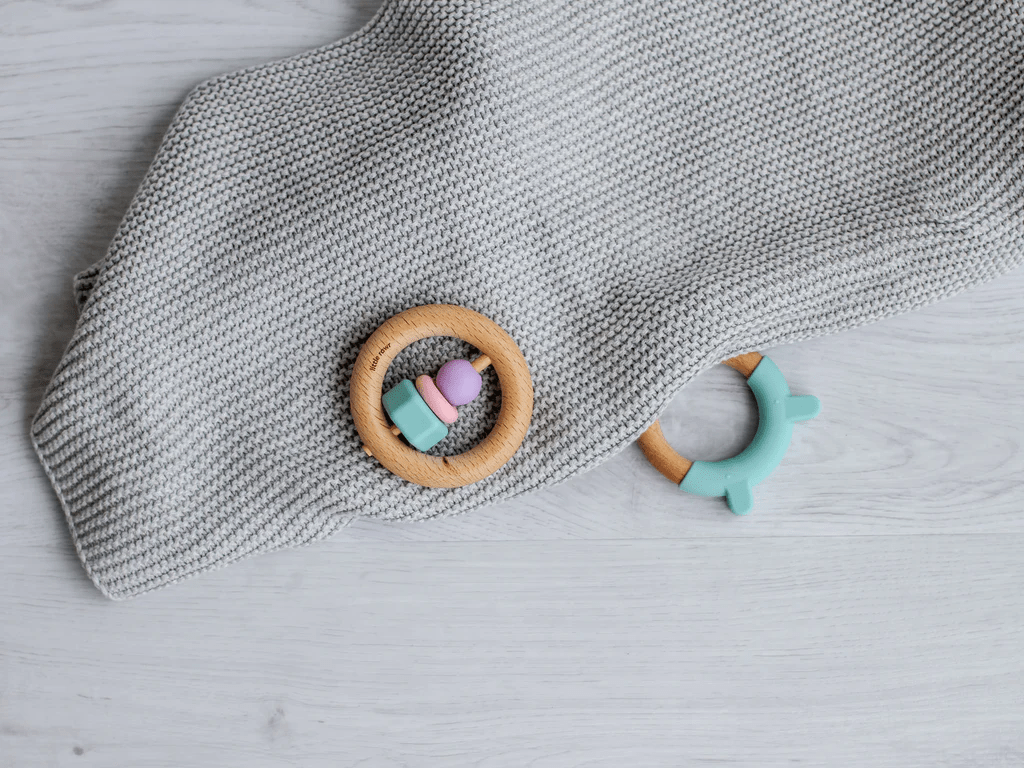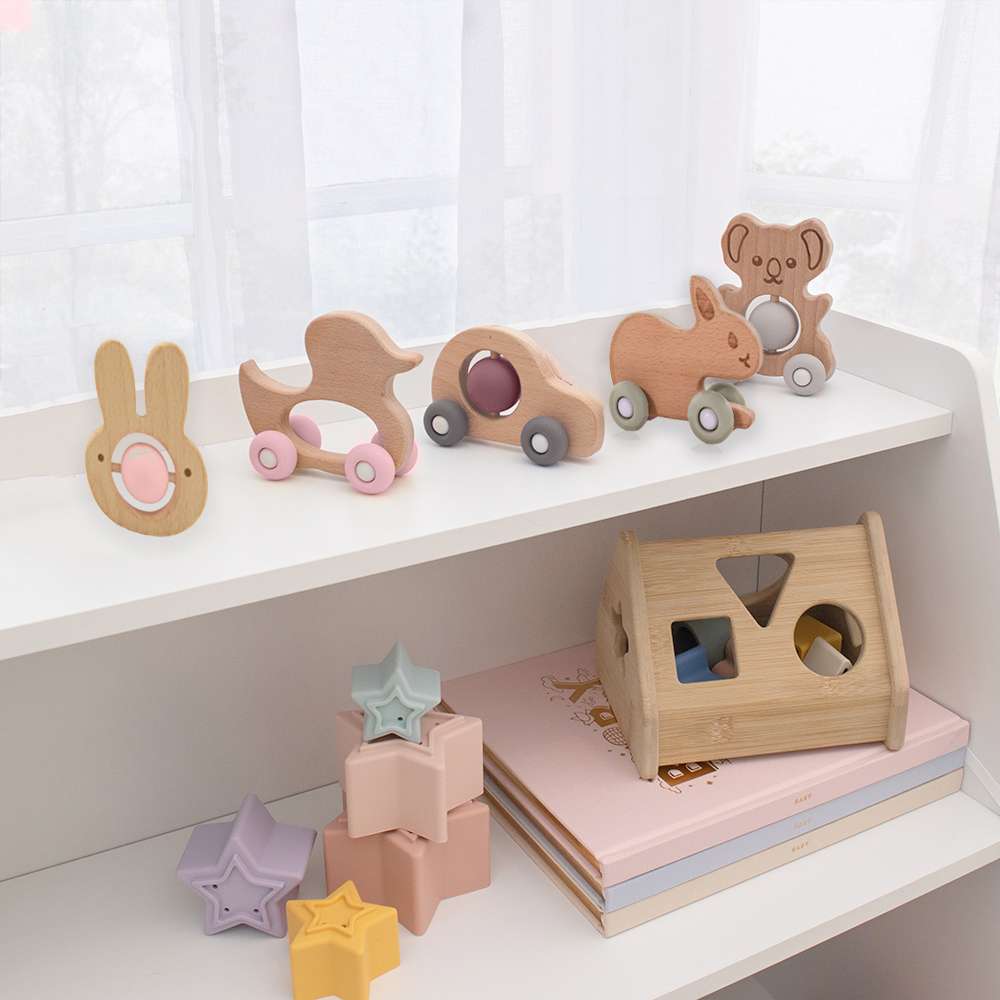The teething stage is so challenging for new parents. Suddenly, it’s a topsy-turvy period of sudden irritability. Of baby’s drooling, hand chewing, and tender gums. All signs – that their teeth are starting to sprout.
Desperate to relieve their pain, you pace the aisles in the baby store or supermarket – searching for some teething relief. You sit up late at night browsing online for just the right teething aid to soothe your baby’s gums. The confusion is there are so many teething toys to choose from! The good news is though – many are labeled ‘non-toxic’ and safer for babies to use.
But what exactly does ‘non-toxic’ mean? Why are teethers, like ‘beech wood’, ‘silicone’, and ‘rubber’ deemed safer for babies who are teething?
So many names, and so little time. This is why in this article, we’ll help you understand what these terms mean. We’ll explain why non-toxic BPA-free teethers are the best choice and show you how good they are for your baby’s health and development. So, you’ll develop the know-how to pick and choose the kind of natural teethers that are safe for your baby.
The importance of non-toxic teethers: how to choose safe options
but first… what is non-toxic and why is it important for teethers?
Before teethers are available to the consumer, they must comply with an extremely high standard of safety regulations. To achieve these standards the teethers must undergo rigorous testing to be approved as non-toxic and safe for babies to use.
This includes testing for a large list of chemicals, heavy metals, phthalates, and BPA. Secondly, they must also meet food-grade chemical testing, since babies are prone to putting things in their mouths. Thirdly, in the case of baby teethers – they must also meet a specific toy safety standard according to the ACCC.
The dangers of toxic materials, including lead, phthalates, and BPA
In a nutshell, BPA and phthalates are often found in plastic products that we use every day. This can include baby products such as baby bottles, sippy cups, dummies, and teethers. Unfortunately, these chemicals are associated with a variety of baby health issues: including hormonal and developmental problems.
Babies are especially vulnerable during these early developmental years and can be potentially at a greater risk of exposure to BPA and phthalates. This is especially true as they are more susceptible to ingesting it into their bodies. This is why now, companies are now making teethers BPA and phthalate-free.
According to health.nsw.gov.au, lead is another natural heavy metal, often used in industry. It can be spread widely in the environment through contamination of water, dust, soil, and some paints. Children under 5 are at an even greater risk as they put their hands or objects into their mouths frequently. This means they can potentially swallow more lead than adults can.
Their brains are still developing, so they are even more sensitive to the effects of lead. If ingested, lead exposure in childhood can cause behavior and attention problems, learning difficulties and cognitive losses. It may also affect physical growth, blood cell development, and the functioning of the kidneys.
The dangers of toxic teethers and how to avoid them
Keen to avoid these risks? To decipher the good from the not-so-good, perhaps it’s time to call your sleuthing skills to action. To start with – double-check product labels for information on what the teethers do and don’t contain, and have a glimpse at the product’s certification marks.
To make things easier for you, let us explain what the most used ‘non-toxic’ materials are for teethers, including silicone, beech timber, and natural rubber. We’ve also included the benefits of each material, its safety, durability, and ease of cleaning.

A list of commonly used non-toxic materials for teethers and their benefits
1. Silicone
According to baby-button.com, silicone is not plastic, but a kind of rubber. It has the following properties similar to plastics, including transparency, ductility, temperature resistance, flexibility, and water resistance. Composed of silicon and oxygen, with organic particles attached to the silicon atoms, it is hypoallergenic and impenetrable to dirty particles. This is what makes it suitable for creating safe, chewy, and soothing baby teethers.
Benefits
– does not support the growth of microorganisms
– resistant to oxygen, ozone, and ultraviolet (UV)
– low chemical reactivity and low toxicity
– The elasticity of silicone promotes a good grip, so it won’t slip out of the baby’s hands
– silicone teethers do not contain BPA, PVC, and phthalates
Safety + durability
Silicone teethers made of food-grade silicone, use a completely safe silicone material that is compatible with food. Silicone is soft and chewy due to its rubbery feel. It can soothe your baby’s gums and remains durable for a long time. It’s also suitable for storage in the refrigerator. This is because its ingredients are very resistant to temperature changes. All the better to provide soothing relief for your baby!
Easy of cleaning
Conveniently silicone teethers are suitable for the refrigerator and dishwasher. Silicone can be safely cleaned with detergent as this cannot penetrate the surface. Just wash with warm soapy water or pop in the top rack of your dishwasher.
2. Beechwood
Did you know that beechwood has natural antimicrobial properties and is therefore naturally antibacterial? That is great peace of mind for parents, especially when baby teethers are constantly in our baby’s mouths. Beechwood is an organic material that can be grown in renewable and managed forests, which is better for the environment. It is naturally non-splintering and has a beautiful scent that can help calm and relax the baby when teething.
Benefits
– sustainable environmentally friendly BPA FREE + Paraben Free
– contains no PVC or Phthalates
– naturally non-splintering
– an organic material with a beautiful natural fragrance
Safety + durability
Beechwood timber is far more durable than most other teethers. This means that your wooden teether can be used for a longer period of time than many other plastic teethers you see elsewhere. Because they tend to last longer, they create less waste from otherwise disposable products that would go to landfill. Beechwood is non-toxic and free from harmful leads, metals, BPA, chemicals, or phthalates.
Easy of cleaning
Beechwood teethers naturally contain antimicrobial and antibacterial properties. This helps to combat any germs making their way to your baby’s mouth. So, when it’s time to clean, simply wash it with soap and warm water, then allow it to dry thoroughly. It’s as simple as that!
3. Natural rubber
Technically, natural rubber is made from the sticky sap, known as latex, that comes from rubber trees. Molding natural rubber means there are no joins or cracks where dirt and bacteria can accumulate. Natural rubber also contains non-static properties meaning it does not attract dust and dirt. The best thing about it? Natural rubber is produced with a sustainable raw material, making it a planet-friendly product!
Benefits
– extremely hygienic environmentally friendly
– BPA FREE + Paraben Free
– contains no chemical softeners
– a natural material that can easily be molded to many shapes
Safety + durability
Natural rubber is a durable material. This means that the material itself doesn’t have joins or air bubbles, and can be easily molded. It is always worth checking however if a rubber teether is solid or hollow. Hollow teethers can allow moisture and germs to become trapped inside where mould and bacteria can flourish. This can pose a risk to the baby’s health if ingested.
Easy of cleaning
A quick wipe with some soapy water and a damp cloth is all that’s needed. No dishwashing is advised, as this will damage the rubber.
babies and their development
Non-toxic teethers benefit babies and their development. According to a survey of 500 pediatricians, 95% of them recommend their patients use natural baby teethers over plastic options. This is due to the numerous benefits they are known to provide.
When looking for the perfect teether for your baby’s development, it’s vital to select one that is also age-appropriate. Also, parents should always supervise their baby when chewing any type of teether. This is to ensure it stays intact and isn’t causing any discomfort or danger.
The benefits of non-toxic teethers for babies and their development
pain relief
Natural materials such as beechwood, rubber and silicone provide different textures for sensory exploration. They also help soothe sore gums when your baby’s teeth develop and offer counterpressure that may reduce your baby’s teething pain. Your baby’s textured teething toys will be a great support on the teething journey.
stimulation
Unlike synthetic teethers that have a smooth surface, natural teethers often come in a variety of shapes and textures. They give your baby something interesting and stimulating to explore with their hands and mouths. This tactile stimulation can help develop hand-eye coordination and boost their fine motor skills.
cognitive development
Natural teething toys encourage stimulating play. This is because they are often designed in the shape of animals or other objects that babies find fascinating. This helps to develop their cognitive skills while engaging them in a safe environment.
safety
Natural teething toys are generally considered to be much safer than plastic alternatives due to their durability and lack of nasty chemicals. Furthermore, these materials are more likely to hold up against the wear and tear from teething babies. This is opposed to some plastic toys that can easily break or splinter when chewed on.
Tips for choosing the best non-toxic teether for your baby
- Need some help choosing the best non-toxic teether for your baby? Here are some tips on how to choose the best natural teether to soothe your baby’s gums.
- choose a safe, durable teether
- Look for a durable material for your teether such as wood or rubber that won’t easily splinter or break apart. Also, make sure the teether you find has no hard or sharp edges.
- choose a non-toxic, clean teether
- Make sure the teether is free from any harsh chemicals or toxins. Also, it has antibacterial properties and is environmentally friendly.
- choose a sensory teether
- Choose a sensory teether with different textures and shapes that will stimulate the senses and provide teething comfort.
- choose an easy-to-clean teether
- Also, try to find a teether that’s made of food-grade silicone and antibacterial beechwood that are easy to wash.
- And lastly … choose an age-appropriate teether
- Remember that a baby’s teeth grow in stages. Therefore, try to find a teether that grows with your baby.
- recommendations for some of the best non-toxic teethers you can check luqubaby teethers.












